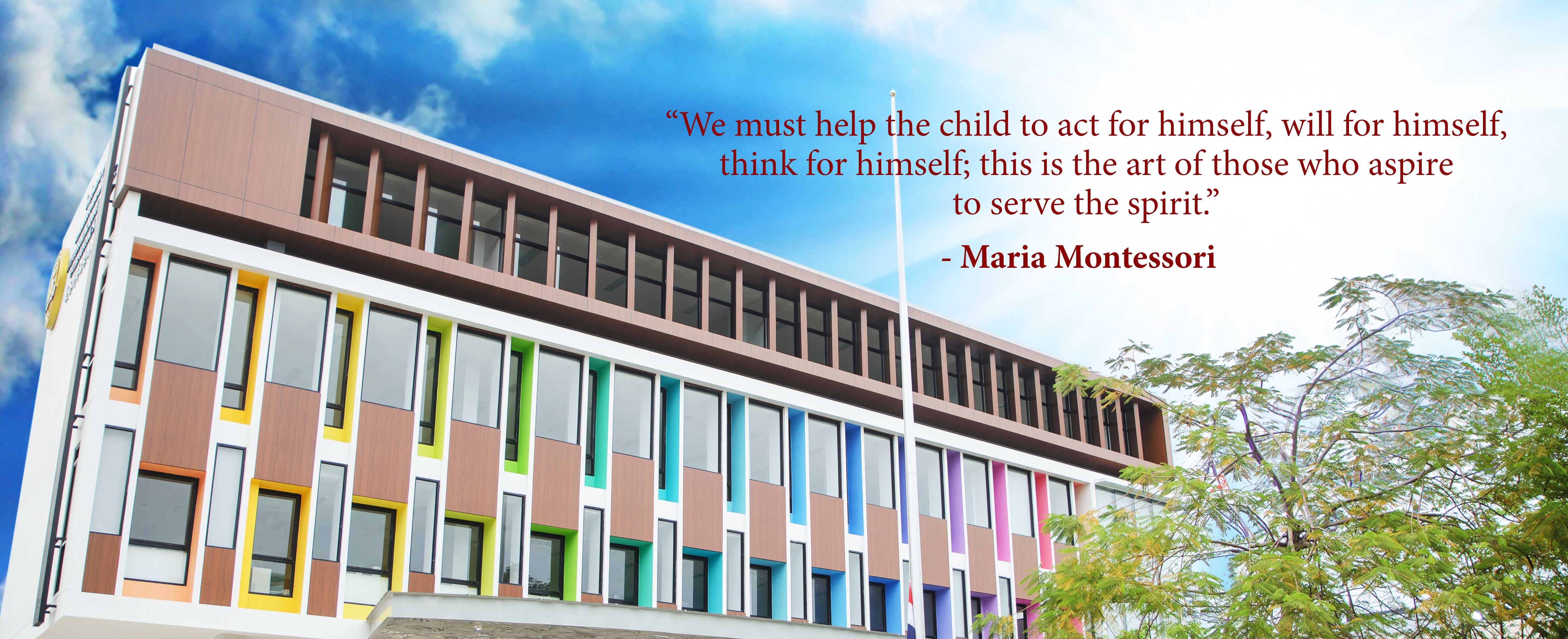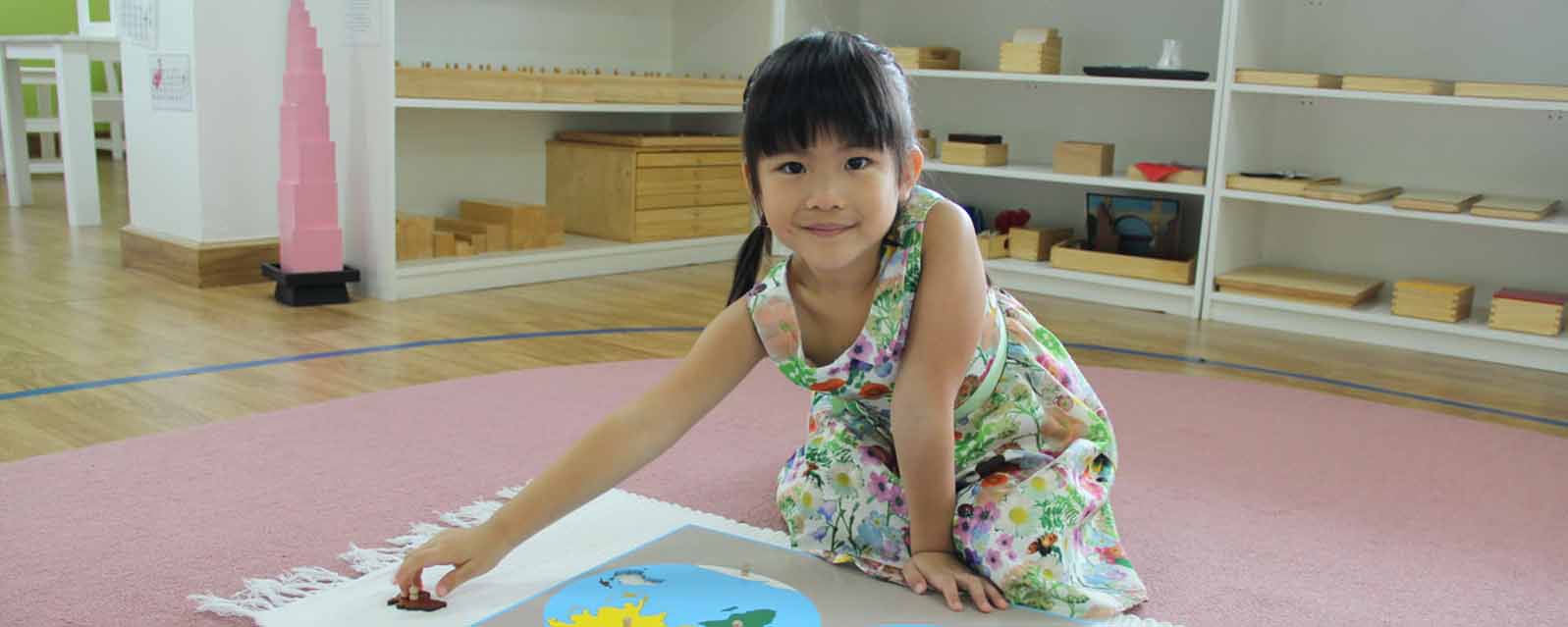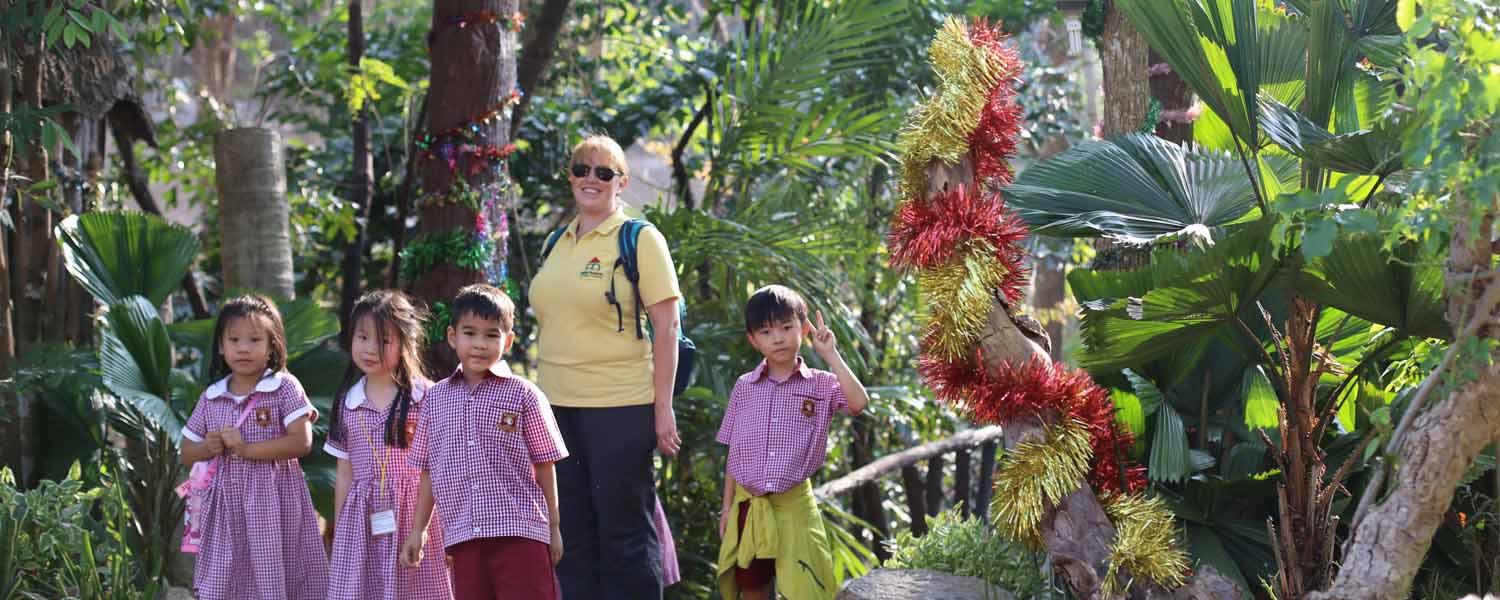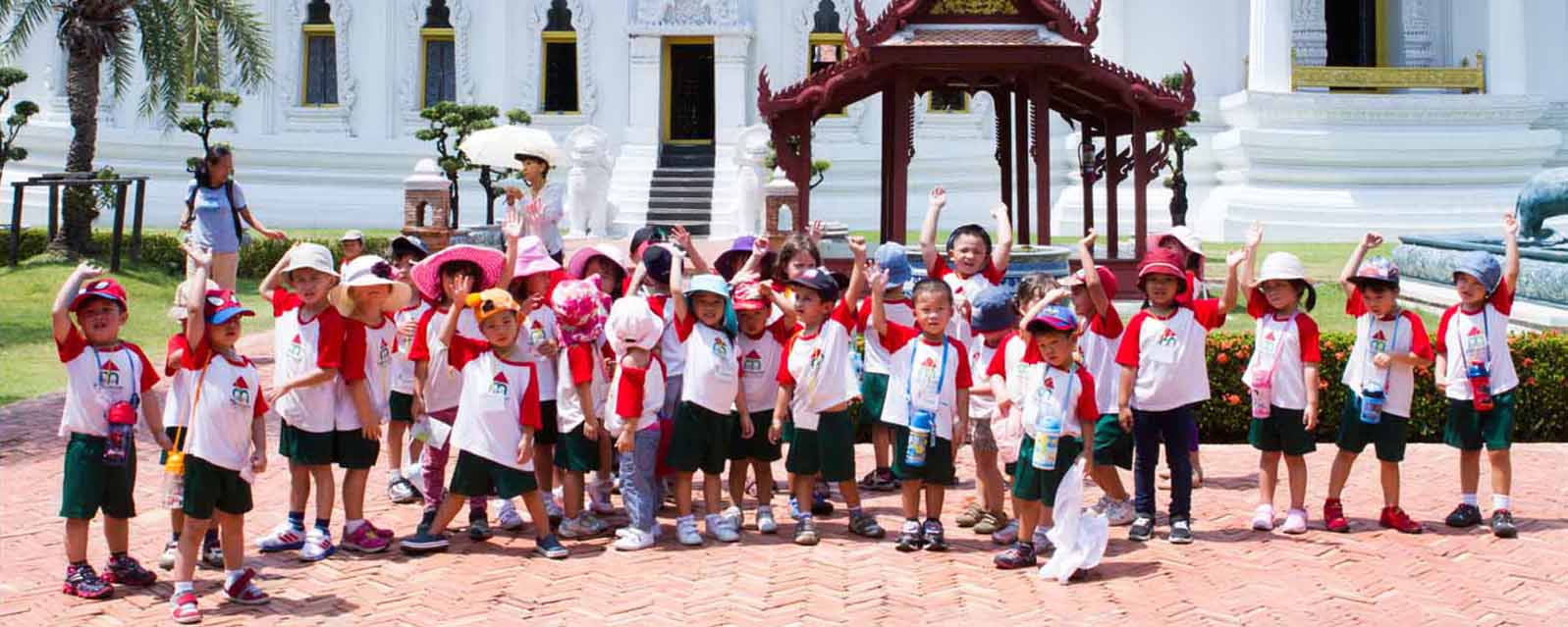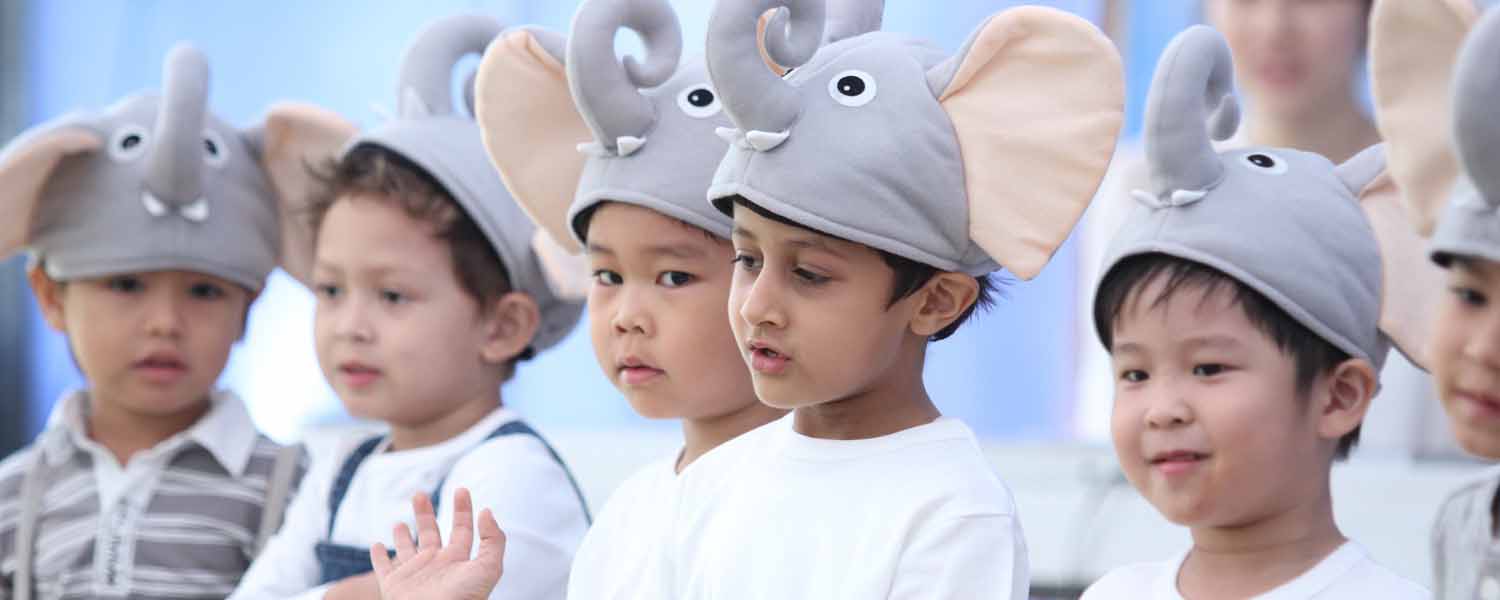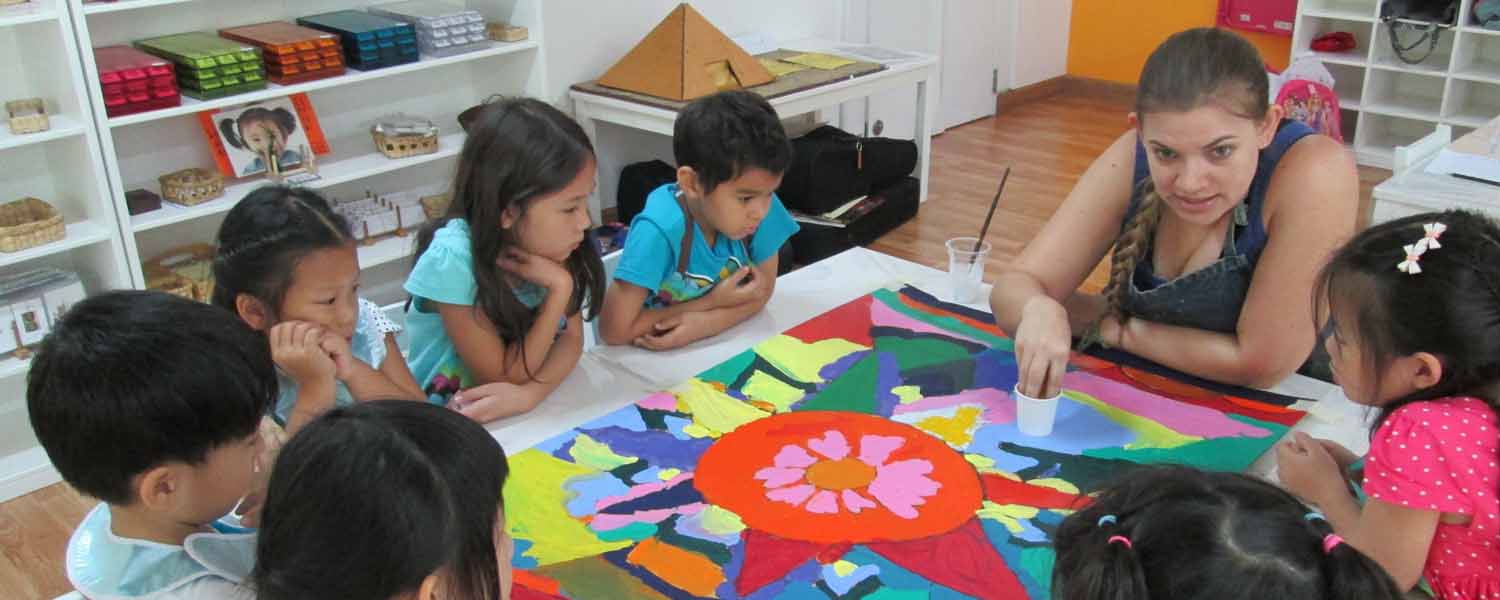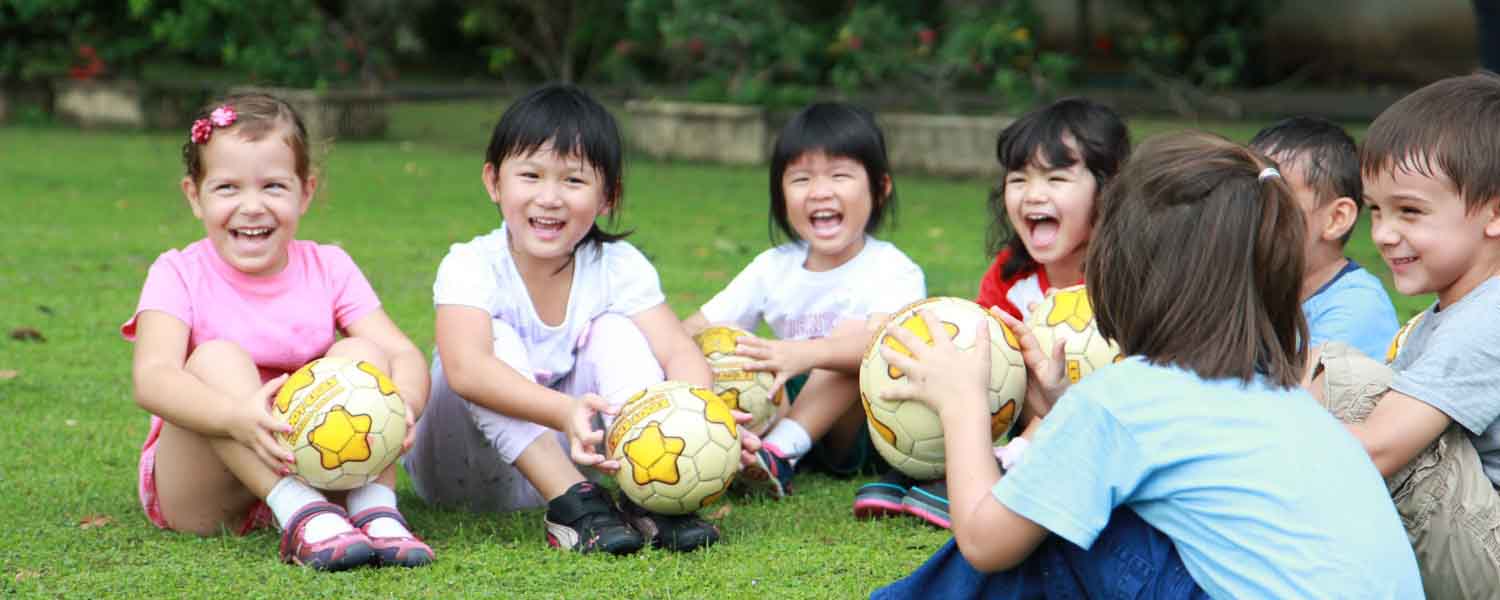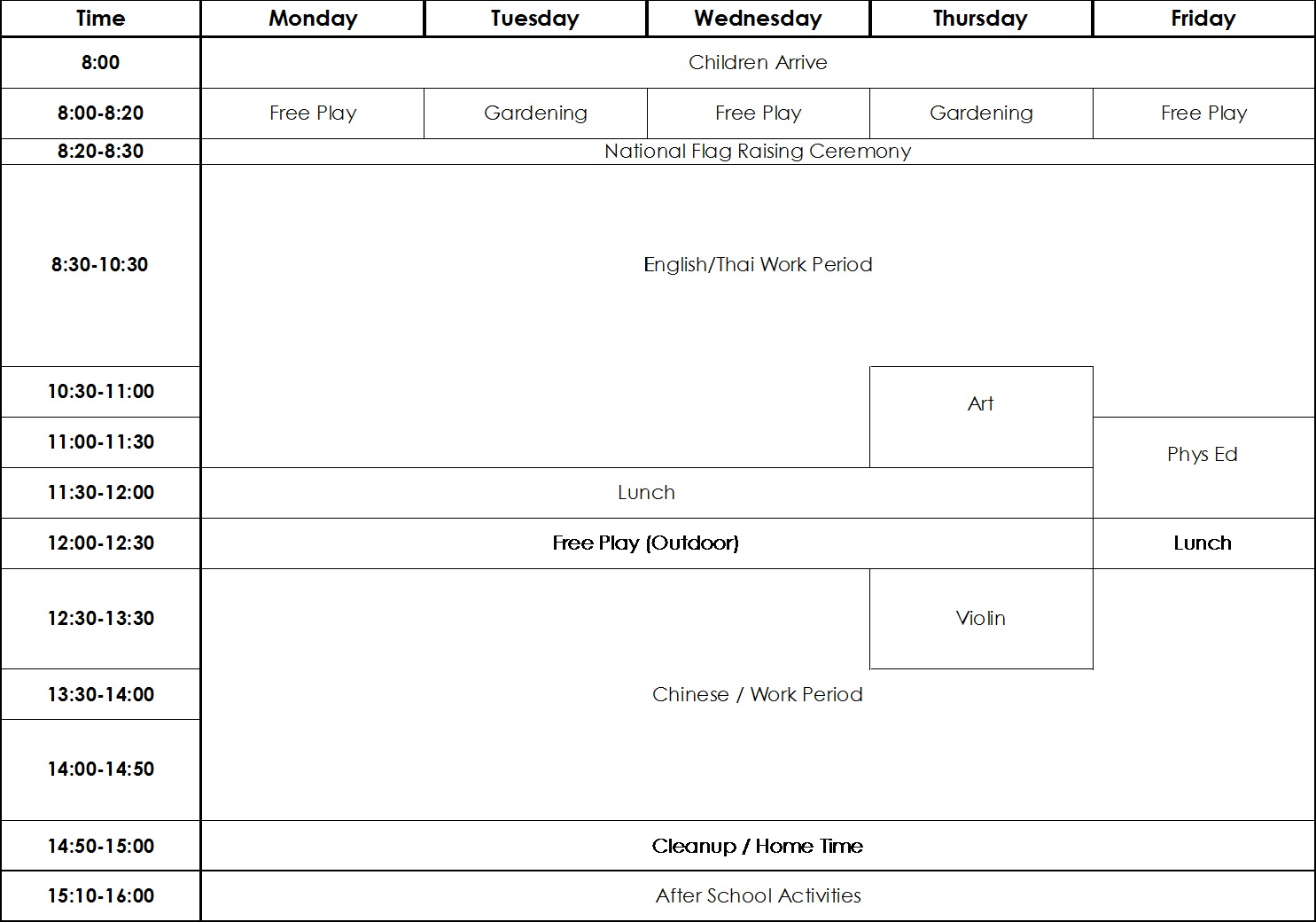Elementary (6-12 years)
The Montessori Elementary Program: Cosmic Education
The Montessori Elementary program consists of separate mixed age classrooms: Lower Elementary for children between the ages of 6 and 9 years, and Upper Elementary for children between the ages of 9 and 12 years. It highlights imagination and genuine, spontaneous interest as the keys to learning.
Montessori Elementary education aims to ignite children’s interest by framing the curriculum within imaginative and unifying stories called the Five Great Lessons. These Great Lessons are successive and inter-related and provide the child with a global vision of unfolding life and culture.
They are followed by Key Lessons which allow the child to delve into more intense study and research of specific interest areas.
Montessori Elementary Program: Curriculum Subject Areas
The Lower Elementary (6-9 years) and Upper Elementary (9-12 years) curriculums include the study of Language (English, Mandarin and Thai), Math, Geometry, History, Geography, Science, as well as Technology, Art and Music, and Physical Education.
Lower Elementary covers Grades 1-3 in the US system. Upper Elementary covers Grades 4-6 in the US system.
Language
The Lower Elementary Language curric ulum builds upon previous language work in the Casa classroom and provides rich opportunities for social interaction, and oral and written language practice. The Language curriculum is introduced with the Story of the Communication in Signs which relates the origins of written language.
ulum builds upon previous language work in the Casa classroom and provides rich opportunities for social interaction, and oral and written language practice. The Language curriculum is introduced with the Story of the Communication in Signs which relates the origins of written language.
Language study includes the informal acquisition of vocabulary and nomenclature associated with the study of geography, science, math, history and geometry as well as a formal study of grammar and style.
 Written expression includes creative writing, written accounts and reports, poetry, and letter writing. There is a strong emphasis upon spelling practice and refinement of handwriting technique.
Written expression includes creative writing, written accounts and reports, poetry, and letter writing. There is a strong emphasis upon spelling practice and refinement of handwriting technique.
Role playing of specific social skills, and practice in presenting work to the class or to small groups help children develop confidence and communication skills. Reading and comprehension skills are developed through a diverse and extensive range of accessible reading material and activities that require reading for meaning.
The Upper Elementary curriculum includes more complex sentence analysis, the study of poetry including rhythm and figures of speech, work with tense, further examination of style, literature, and the history of both written and spoken language. There is increased emphasis on the process of producing pieces of independent writing, the deconstruction and construction of different genres or text types, drafting, revising, editing and publication of the final product.
While English will be the primary language used for the Montessori curriculum, Mandarin and Thai will also be supported. The Thai language program will follow the guidelines of the Thai National curriculum. The Mandarin program will follow a Singapore-based curriculum which was developed especially for Montessori programs.
Math
 The Math curriculum builds upon the concrete math activities of the Casa classroom leading children to increasingly abstract work. It is framed within The Story of Numbers which relates the origins of numbers and the history of the development of the present day number system from Babylonian cuneiform writing.
The Math curriculum builds upon the concrete math activities of the Casa classroom leading children to increasingly abstract work. It is framed within The Story of Numbers which relates the origins of numbers and the history of the development of the present day number system from Babylonian cuneiform writing.
Key Lessons related to measurement, the operations of addition, subtraction, multiplication and division, the memorization of addition and multiplication tables, together with a range of mathematical materials provides opportunities for children to be working abstractly with long multiplication and division by 9 years of age. Montessori math activities provide the opportunity for counting in multiples up to 1,000, to explore the decimal system, working with numbers up to the millions and establishing a firm understanding of place value. Children work extensively with fractions, and are introduced to algebra and the pre-requisites of squaring and cubing, and preparation for future work with binomial and trinomial equations in the Upper Elementary class.
The Upper Elementary Math curriculum provides a comprehensive exploration of algebra, as well as work with square and cube roots, the powers of numbers, decimal fractions, ratio and proportion, non-decimal base systems, and signed numbers.
Geometry
 The Lower Elementary Geometry curriculum is framed within the story ‘How Geometry got its Name’, an account of the origins of geometry 5,000 years ago on the banks of the Nile River. It involves an extensive exploration of plane geometry including the exploration of triangles and the concepts of equivalence, similarity and congruence, the exploration of lines, quadrilaterals, angles, the use of a protractor and compass, and the measurement of angles.
The Lower Elementary Geometry curriculum is framed within the story ‘How Geometry got its Name’, an account of the origins of geometry 5,000 years ago on the banks of the Nile River. It involves an extensive exploration of plane geometry including the exploration of triangles and the concepts of equivalence, similarity and congruence, the exploration of lines, quadrilaterals, angles, the use of a protractor and compass, and the measurement of angles.
The Upper Elementary Geometry curriculum presents a range of material not previously encountered in the Lower Elementary class. This material provides the opportunity for further concrete exploration of equivalence and congruence, for exploration of the measurement of area and volume (via the work with solid geometry), and an introduction to Pythagorean and Euclidian geometry. This leads to the derivation and application of formulae for the calculation of area and volume, including the area of a circle, the volume of a cylinder and cone, the lateral and total areas of a cylinder and pyramid.
History
 The Lower Elementary History curriculum presents a number of broad conceptual keys for the imaginative exploration of time, human progress and culture. These include The Story of the Coming of Life, the Timeline of Life, and the Story of the Coming of Humans with its related timelines. Attention is drawn to the many and diverse ways in which human beings in different parts of the world, and at different times, have sought to meet their needs and achieve their aspirations. This provides a conceptual and organizing principle for the further study of human culture through history. Children are shown how to construct their own timelines, and how to conduct, write and present small research projects relating to their personal and family history.
The Lower Elementary History curriculum presents a number of broad conceptual keys for the imaginative exploration of time, human progress and culture. These include The Story of the Coming of Life, the Timeline of Life, and the Story of the Coming of Humans with its related timelines. Attention is drawn to the many and diverse ways in which human beings in different parts of the world, and at different times, have sought to meet their needs and achieve their aspirations. This provides a conceptual and organizing principle for the further study of human culture through history. Children are shown how to construct their own timelines, and how to conduct, write and present small research projects relating to their personal and family history.
The Upper Elementary History Curriculum provides children with further tools for conducting research. These include specific ‘How to‘ lessons, the History Question Charts, an introduction to the Three Phases of History, the time line of Ancient Civilizations, the Migration Charts, a diverse range of reference materials, as well as opportunities to organize excursions to local museums and galleries for specific research purposes.
Geography / Science

 The Lower Elementary Geography curriculum is introduced with the story of The Beginning of the Universe designed to stimulate awe, wonder and an imaginative connection with the universe. This is followed with scientific experiments that demonstrate the characteristics of solids, liquids and gases and the laws that govern all matter. These are followed in turn by a series of lessons when the teacher uses pictorial aids to lead children step by step to an understanding of the relationship between the rotation of the Earth around the Sun, how this results in night and day and the seasons, how the Earth is sculpted by the work of wind and water, how rivers work, how mountains are formed, and how time zones work. The Geography curriculum also includes the study of political geography and cultural studies.
The Lower Elementary Geography curriculum is introduced with the story of The Beginning of the Universe designed to stimulate awe, wonder and an imaginative connection with the universe. This is followed with scientific experiments that demonstrate the characteristics of solids, liquids and gases and the laws that govern all matter. These are followed in turn by a series of lessons when the teacher uses pictorial aids to lead children step by step to an understanding of the relationship between the rotation of the Earth around the Sun, how this results in night and day and the seasons, how the Earth is sculpted by the work of wind and water, how rivers work, how mountains are formed, and how time zones work. The Geography curriculum also includes the study of political geography and cultural studies.
In the Upper Elementary class there is a continuation of the study of the Sun and the Earth including lessons relating to the Solstices, Equinoxes and the Seasons. The study of the Work of Wind and Water continues with a study of global wind systems and ocean currents, of global river systems, global water cycles, of vegetation zones, and the study of people and culture in different zones. There is an increased emphasis on Human and Economic Geography
Biology / Botany

 The study of biology in the Lower Elementary class includes the use of stories, pictures, charts and a wide range of hand-made reading material for children to explore. The teacher plants the seeds of interest and enthusiasm and step by step leads the child on a path of discovery related to the characteristics and needs of plants and animals, the functions of the parts of the plant, and of the parts of vertebrates and invertebrates. In the Upper Elementary class this leads to an extensive exploration of the scientific classification of the animal and vegetable kingdoms and an introduction to ecology.
The study of biology in the Lower Elementary class includes the use of stories, pictures, charts and a wide range of hand-made reading material for children to explore. The teacher plants the seeds of interest and enthusiasm and step by step leads the child on a path of discovery related to the characteristics and needs of plants and animals, the functions of the parts of the plant, and of the parts of vertebrates and invertebrates. In the Upper Elementary class this leads to an extensive exploration of the scientific classification of the animal and vegetable kingdoms and an introduction to ecology.
Art and Music

 In the Art program students will gain an appreciation of famous artists and styles, and work with a variety of media to express their creativity.
In the Art program students will gain an appreciation of famous artists and styles, and work with a variety of media to express their creativity.
In the Music program students learn about important musical elements such as rhythm, melody, form, harmony, tempo and dynamics, along with their related terminology and analysis. All students take violin lessons and work with the Montessori Tone Bars.
Technology
In the Elementary program, computers are used to facilitate research and writing. Students will learn proper typing techniques and how to use the Internet as a research tool. They will learn to use software to create documents and presentations.
Physical Education
The Physical Education program will include a range of activities, enabling children to develop their gross motor skills, as well as their skills in teamwork and leadership. The aim is to provide children with learning opportunities through the medium of movement and encourage them to lead full, active and healthy lives.




